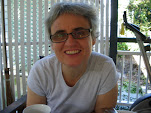


I've been working in the studio at UWIC School of Art...exploring the sensory and graphic elements of the written as visual language dislocated from the sign-specific meaning of words themselves. This is seeing whether theories that originated in linguistics such as Julia Kristeva’s argument for the materiality of language through the gesture of writing have a correlation in visual language. I've also been thinking about Derrida’s absent/presence narrative and the silence of spaces whether it can be interpreted as the artworld’s ‘negative space’. How do writing and drawing relate to each other? Obviously I have a lot to learn about linguistics but thinking about how these concepts translate in the studio is proving very interesting. Drawings in the sequence are currently titled "Out of Sight (of thought)" Drawings are in unfinished works in progress.









In his book, On pictures and the words that fail them, Elkins examines both pictures and writing in relation to semiotic theory. In the first case he examines the rudiments of pictures; their marks, lines, traces and edges in detail that is mostly ignored by semiotics, which, he points out, purports to look at signs yet glosses over individual marks herding them together into elements of scenes making it easy to generalise pictures into narratives. Elkins asserts that by being specific about graphic marks it becomes harder to write about pictures, and his undertaking is to “make pictures more difficult”. He alleges it is the tension between the incomprehensible individual marks and their overall effect is when pictures are most interesting.
ReplyDeleteIn the case of writing, Elkins relates an archaeological debate about inscriptions found on clay tablets from the Vinča culture of c.4000BC and whether these represented writing or not. If you are going to look at pictures as a variety of writing it makes sense to ask the question how do we know we are looking at writing? In detailing the debate Elkins draws attention to various criteria we may apply to assess for signs of writing, such as order, repetitiveness, spacing between marks etc., which we do not usually have to question. The categories of mark that were proposed for the Vinča inscriptions are also brought to attention; such as writing, pre‑writing, pseudo-writing, “senseless imitation” , decorative motifs, magical marks to serve ritual needs and religious expression.
Elkins concludes that text and pictures meet the criteria for signs of writing equally. “Any picture can be understood as failed or incomplete writing, and the same is true of any writing.” A number of artists’ work relates to a fusion of writing and picture, notably Paul Klee’s images with titles such as Script picture 1928, Writing picture 1934 and Alphabet picture 1924, conflate text with images. “His work relates the disjointed domains of the verbal and the visual.”
While Elkins is sceptical about the semiotic model of art he does not dismiss the link between pictures and language. “Claiming marks are signs more or less avoids pictures by making them into other kinds of objects. I do not think pictorial marks can be discussed on the model of written marks but neither are they inarticulate inchoate mutterings forever divided from the signs of language”
Whether or not semiotic theory applies to pictures it does make sense to imagine that words and drawings have a common origin as symbolisations of experience.